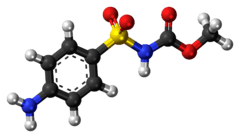Asulam
 | |
 | |
| Names | |
|---|---|
| IUPAC name
N-(4-Aminophenyl)sulfonylcarbamic acid methyl ester | |
| Identifiers | |
| 3337-71-1 | |
| 3D model (Jmol) | Interactive image |
| ChEBI | CHEBI:81696 |
| ChemSpider | 17707 |
| ECHA InfoCard | 100.020.071 |
| KEGG | C18350 |
| PubChem | 18752 |
| |
| |
| Properties | |
| C8H10N2O4S | |
| Molar mass | 230.241 g/mol |
| Density | 1.419 g/mL |
| Except where otherwise noted, data are given for materials in their standard state (at 25 °C [77 °F], 100 kPa). | |
| | |
| Infobox references | |
Asulam is a herbicide invented by May & Baker Ltd , and internally called M&B9057[1] and used in horticulture and agriculture. It is used to kill bracken[2][3] and docks[4] also used as an antiviral agent. It is currently marketed, by United Phosphorus Ltd - UPL, as "Asulox" which contains 400 g/L of asulam sodium salt.
Asulam was declared not approved by the "Commission Implementing Regulation (EU) No 1045/2011 of 19 October 2011 concerning the non-approval of the active substance asulam, in accordance with Regulation (EC) No 1107/2009 of the European Parliament and of the Council concerning the placing of plant protection products on the market, and amending Commission Decision 2008/934/EC (http://eur-lex.europa.eu/LexUriServ/LexUriServ.do?uri=OJ:L:2011:275:0023:0024:EN:PDF).
References
- ↑ "ChemSpider – Asulam – C8H10N2O4S". Retrieved 30 September 2011.
- ↑ R. J. Pakemana, M. G. Le Ducb and R. H. Marrs (1998). "An assessment of aerially applied asulam as a method of long-term bracken control". Journal of Environmental Management. 53 (3): 255–262. doi:10.1006/jema.1998.0207.
- ↑ C. S. R. Snow and R. H. Marrs (1997). "Restoration of Calluna heathland on a bracken Pteridium-infested site in north west England". Biological Conservation. 81 (1-2): 35–42. doi:10.1016/S0006-3207(96)00147-4.
- ↑ R. I. Speight and J. B. Whittaker (1987). "Interactions Between the Chrysomelid Beetle Gastrophysa viridula, the Weed Rumex obtusifolius and the Herbicide Asulam". The Journal of Applied Ecology. British Ecological Society. 24 (1): 119–129. doi:10.2307/2403791. JSTOR 2403791.
Further reading
- Asulam in the Pesticide Properties DataBase (PPDB)